Bridles: Extolling the Virtues of a V-Shaped Bridle
V-shaped bridles are an excellent solution for multiple mooring and anchoring applications. This article by Jimmy Green outlines why V-Bridles are an uncomplicated but extremely beneficial concept and why they are shipshape and not clunky when specified and produced correctly.
Published 11 months ago
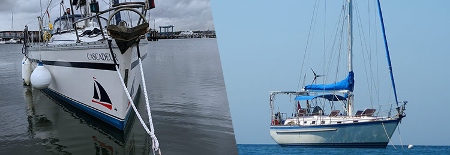

What is a V-Shaped Bridle?
If you have not come across a V-shaped bridle before, when you see one, you will think, wow, that is such a simple but effective idea.
A V-Bridle is one continuous length of rope formed into a V with a central loop or hard eye at the apex, resulting in two tails (or legs).
It is used for sharing one load between two attachment points. Connect the apex of the V to a chain, warp, mooring buoy or any other attachment point, then, make the two tails fast to two strong points.
A Jimmy Green V-shaped bridle is based on the Anchorplait centre eye splice, with or without a thimble included. Crucially, the centre eye splice does not involve any breaks or joins in the line – the soft loop or hard thimble eye is completed with a Brummel locking tuck splice – the locking element is fundamental to the security of the centre eye splice.
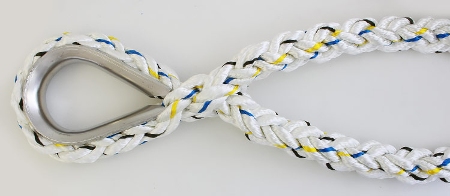

How strong is a V-Bridle?
A significant factor in terms of strength is that this design is based on one single continuous line. The other major factor is that a Brummel Lock centre eye splice can maintain a remarkably high proportion of the original linear break load of the rope if it is carried out to a professional standard. An accomplished rigger will ensure that all the strands maintain their optimum structure.
Tensile strength is maximised when all the strands take the strain equally and as longitudinally as practicable. If you are attempting the splice yourself, do not underestimate the importance of settling all the strands back into place without deformation.
What about splicing two ropes together?
This is not the best idea. A splice that joins two separate ropes together, effectively creating a Y-shaped connection, is potentially a weak link in any mooring or anchoring system.
Merging two separate lines with a splice featuring five tucks plus a tapering tuck may retain a disappointingly low percentage of the rope’s break load at anything other than the optimum angle.
V-Bridle Rope and Splicing Construction
Anchorplait®, also known as Octoplait or Squareline, is an eight-strand rope designed and manufactured with four equal pairs of strands, two left-hand laid and two right-hand laid, making the rope flexible, balanced, stable, resistant to twist and ideal for the centre eye splice. The method is innovative and relatively simple to follow, and if the principles are meticulously upheld, the result will be a strong, secure, and enduring splice.
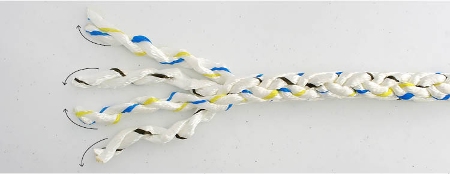

Important Note: Fundamentally, the very nature of the odd number of strands makes it impossible to successfully complete a centre eye splice in a twisted lay, three-strand rope.
V-Bridle Principles
The maximum deployment angle of the bridle must always be set up with caution. Too wide an angle will put too much strain on the rope and the centre eye splice. It is the same old story. Ropes are designed to withstand a straight pull but are vulnerable to sharp bends or kinks, so the best angle will coincide with the natural direction of the rope as it emerges from the splice.
However, if the required angle is wider than ideal, the centre eye splice will be much more secure than any joining splice between two separate ropes. As the bridle angle opens, the advantage of a centre eye splice over two ropes spliced together increases dramatically.
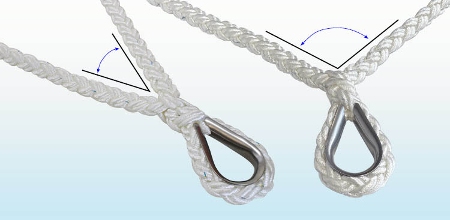

The bridle on the left-hand side (above) illustrates the lines emanating from the splice in a direction sympathetic to their original designed structure. The bridle on the right-hand side is pushing the limit, making the angle wider than ideal for the line and the splice.
The Advantages of a V-Bridle over a Single Line
The V-Bridle is a superb solution for sharing one load between two attachment points. Connect the apex of the V to a chain, warp, mooring buoy or any other attachment point. Then, make the two tails fast to two strong points. At the forward and after end of a yacht, this has fantastic advantages over a single line because the port and starboard mooring cleats and fairleads can be utilised, avoiding any congestion on the centreline.
At the bow, the stemhead and roller will almost certainly already be used, so avoiding that area will be hugely beneficial. A single line may foul the rudder or steering position at the stern, and there is rarely a mooring cleat in a suitable position.
The Advantages of a V-bridle over Two Separate Lines
A V-Bridle is simply less cumbersome, featuring one thimble instead of two, and, consequently, avoiding doubling up on the connecting shackles as well.
Where Two Lines may be Preferable
The deployment angle should be considered carefully. For multihulls, the angle may be too obtuse for a V-Bridle to take the load sensibly. Lengthening the tails will lessen the angle but may not be practicable due to the need to constrain the swinging radius of the yacht.
V-Bridle Applications
These are the primary uses for V-Bridles, although there may be more:
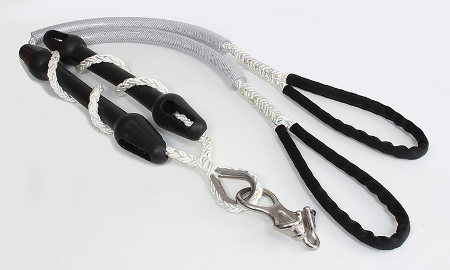

Anchor Chain Snubbing V-Bridles
Chain Snubbing Lines are an excellent means of transferring the strain from your windlass to a deck cleat or mooring post while at anchor on an all-chain rode. Snubbing lines also provide excellent additional shock load absorption, helping to smooth out any snatches and jerks caused by the wind and sea state. The longer the line, the more it will soften the ride to anchor.
Select a line diameter comparable to your bower anchor warp or compatible with your anchor chain size, bearing in mind that the belt and braces approach for this particular job probably is not the way to go.
That is because if you use a line diameter that is too large (strong), you will negate the advantage of the rope’s elasticity. For the same reason, an undersized line will stretch more but may ultimately prove sacrificial.
Alternatively, you can add mooring compensators to add extra springiness to the setup. See an example here.
Remember that the chain should be secured to a cleat or chain stopper just in case the sacrificial element of the snubbing line comes into play. The windlass should only be the strongpoint of last resort because the internal workings are not designed to absorb snatch loads.
V Shape Mooring Bridles Custom Splice Steps.


Splicing a chain hook, gripper or grab onto the apex of the V-Bridle makes for easy attachment and detachment of the chain.
Lead one tail back through the forward port fairlead and the other tail back through the forward starboard fairlead and make them fast to the main forward mooring cleats.
You can make the tails a fixed length with a spliced loop finish for easy making off or make them a little longer with whipped ends for length adjustment. Bear in mind that you may want a good long length out while there are no crew on board, but a much shorter, more convenient length out for more temporary anchoring. You can mark the tails to ensure that the bridle is symmetrical.
A Note on Single-Line Chain Snubbing – A single snubbing line can be routed over the bow roller or offset through the forward mooring fairlead as a short-term solution. For an extended time at anchor, especially unattended, the bow roller may not be wide enough to accommodate the extra line without causing abrasion or jamming issues. If the bow roller route is available and trouble-free, then a single line will be fine, but a V-Bridle avoids using the bow roller altogether.
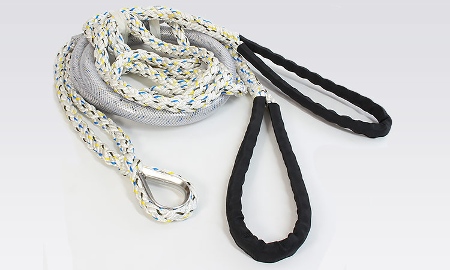

Mooring V-Bridles for a Swinging Mooring or a Trot
A single Eight-Strand rope to a buoy with copious chafe protection is a popular way to set up your home swinging mooring. However, a V-bridle will be the best option if the route through the stemhead fitting and over the bow roller is not viable and you have well-sized toe rail fairleads and strong deck cleats.
You will need a similar length for each tail and, most importantly, the same diameter line as it would be for a single line swinging mooring strop.
Although the V-Bridle shares the total load between the two tails, it is rarely divided equally because as the yacht veers, one tail will take proportionally more of the strain while the other tail goes slack. As the wind continually shifts and oscillates, the yacht will veer back and forth and seldom be head to wind for long.


Towing Warp Attachment and Yacht Drogue or Parachute Anchor Deployment
Attaching a single line amidships at the stern may not be an option because few yachts have a suitable cleat positioned in the middle of the transom. A V-bridle can be made fast to the stern quarter mooring cleats, keeping the lines from interfering with the rudder, tiller, or steering position, and may help avoid fouling the propeller, too.
The tails of a V-bridle can be adjusted to offset the line according to sea conditions. This is particularly helpful for towing or deploying a yacht drogue from the stern. A V-bridle will also add to the stability of any towing or drogue warp deployment.
For parachute anchor deployment, the same principles and advantages apply as for your chain snubbing, albeit with potentially a stronger bridle to cope with severe weather conditions.
…………………………
About the Author
Jimmy Green Marine is a family-run business founded by brothers Alistair and Mike Green, based in the coastal fishing village of Beer in East Devon. The company started as a Mail Order Chandlers in 1981 and has continually evolved from attending Boat Shows and Boat Jumbles in the early days to now trading globally online.

Four decades of exporting experience combined with an intuitive website shipping calculator means that you can have your order delivered to your home, business or direct to your yacht anywhere worldwide.
Their flagship, innovative Custom Build website system provides an instant quote for all your professionally spliced and finished wire and rope rigging, mooring and anchoring solutions.
You can access this online from wherever you can get an internet connection, however remote.
Alistair Green is an experienced sailor and rigger with over 40 years of experience in the marine industry. He is passionate about providing his customers with the best possible products and services and is always looking for new ways to improve the business.
If you are looking for a reliable and experienced marine supplier, then Jimmy Green Marine is the perfect choice.
Visit their website today to learn more about their products and services.
…………………………
Related Links:
- About Jimmy Green Marine
- Custom Splicing, Rigging and Sewing Service
- Worldwide Shipping
- Jimmy Green Marine joins Noonsite.com as Official Ropes and Rigging Partner (April 2023)
Other Articles by Jimmy Green Marine:
- Mooring Lines – Horses for Courses (November 2023)
- When to Replace your Standing Rigging (October 2023)
- Ten Reasons to Whip and Stitch Your Ropes (September 2023)
- How to Choose your Next Anchor Chain (August 2023)
- How to Choose a New Halyard (July 2023)
- The Uses and Benefits of Rope Splicing Onboard a Yacht (May 2023)
………………………………
The opinions expressed in this article are the author’s own and do not reflect the view of Noonsite.com or World Cruising Club.
………………………………
Find out all news, reports, links and comments posted on Noonsite, plus cruising information from around the world, by subscribing to our FREE monthly newsletter. Go to https://www.noonsite.com/newsletter/.
Related to the following Cruising Resources: Equipment, Marine Supplies




